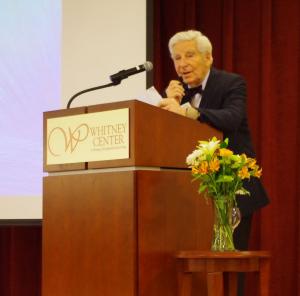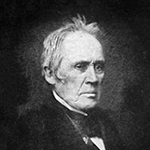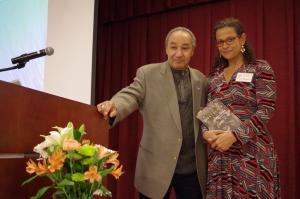Lecture by Alison Stewart, journalist and author of First Class. — “Back to the Future-Lessons to be learned from Dunbar, America’s First Black Public High School.”
The 1434th meeting of the Connecticut Academy of Arts and Sciences was held on Wednesday, March 12th, 2014 at 5 p.m. at the Whitney Center in Hamden. Some 30 members and their guests enjoyed wine and the lecture and some 20 people stayed for dinner.
The President, Dr. Gregory Tignor began the evening program by welcoming the audience to the 1434th meeting of the Academy.
 He asked past President Dr. Ernest Kohorn to introduce the speaker for the newly instituted tradition of a five-minute biography of a Founding Father of the Academy. Dr. Kohorn said that Professor Wheeler was a member of long standing and a very valuable member of the Academy’s Council. He was also an internationally renowned emeritus professor of Physics at Yale. Because of his scientific interest in ceramics he had unearthed many hidden treasures at the Peabody Museum in New Haven. Professor Wheeler’ s subject was Benjamin Silliman.
He asked past President Dr. Ernest Kohorn to introduce the speaker for the newly instituted tradition of a five-minute biography of a Founding Father of the Academy. Dr. Kohorn said that Professor Wheeler was a member of long standing and a very valuable member of the Academy’s Council. He was also an internationally renowned emeritus professor of Physics at Yale. Because of his scientific interest in ceramics he had unearthed many hidden treasures at the Peabody Museum in New Haven. Professor Wheeler’ s subject was Benjamin Silliman.
 Born in 1799 in Stratford to the American Revolutionary General Gold Sellek Silliman, Benjamin Silliman was a very influential member of the Academy during most of the 19th century. He entered Yale College at the age of 17, received an M.A. three years later, was a Yale college tutor and he was a lawyer, passing the bar at the age of 23. Yale’s President, Timothy Dwight, had $20,000 for 3 new professorships, beginning in 1793. In 1802 he asked Silliman to become a Natural Scientist. Silliman spent a year at Franklin’s institution the University of Pennsylvania, taking chemistry instructions from Professor Woodhouse. Silliman’s first lectures in Chemistry were held in 1804 in Yale College. The origin of the $20,000 resided in the Treaty of Paris of 1782 part 111. This specified that in the future all the states were to honor the charters made during the colonial period. But in Connecticut the clergy at Yale and the legal representatives could not agree on the nature of the support and governance of the college. A divorce was the solution. An agreement was made whereby Yale would receive $20,000 and the state would no longer have any monies due to Yale. The college agreed the state would have representation on the Yale Corporation forever in the persons of the Governor and the Lieutenant Governor. During the year 1805-1806 Silliman went to England, Scotland and Holland with about $ 10,000 in order to purchase apparatus and books. He collected the bookseller’s fee. He founded the American Journal of Science in 1818, was an advisor to President Lincoln and a founding member of the National Academy of Science. He married Harriet Trumbull, the daughter of the Governor and lived to be 85. His statue stands outside the Sterling Chemistry Laboratory. It is of note that his son’s research at the Yale Scientific School in 1854 was on fractional distillation, a technique developed by his father. His report on creating refined oil from Pennsylvania rock oil was a major factor in the development of the oil industry.
Born in 1799 in Stratford to the American Revolutionary General Gold Sellek Silliman, Benjamin Silliman was a very influential member of the Academy during most of the 19th century. He entered Yale College at the age of 17, received an M.A. three years later, was a Yale college tutor and he was a lawyer, passing the bar at the age of 23. Yale’s President, Timothy Dwight, had $20,000 for 3 new professorships, beginning in 1793. In 1802 he asked Silliman to become a Natural Scientist. Silliman spent a year at Franklin’s institution the University of Pennsylvania, taking chemistry instructions from Professor Woodhouse. Silliman’s first lectures in Chemistry were held in 1804 in Yale College. The origin of the $20,000 resided in the Treaty of Paris of 1782 part 111. This specified that in the future all the states were to honor the charters made during the colonial period. But in Connecticut the clergy at Yale and the legal representatives could not agree on the nature of the support and governance of the college. A divorce was the solution. An agreement was made whereby Yale would receive $20,000 and the state would no longer have any monies due to Yale. The college agreed the state would have representation on the Yale Corporation forever in the persons of the Governor and the Lieutenant Governor. During the year 1805-1806 Silliman went to England, Scotland and Holland with about $ 10,000 in order to purchase apparatus and books. He collected the bookseller’s fee. He founded the American Journal of Science in 1818, was an advisor to President Lincoln and a founding member of the National Academy of Science. He married Harriet Trumbull, the daughter of the Governor and lived to be 85. His statue stands outside the Sterling Chemistry Laboratory. It is of note that his son’s research at the Yale Scientific School in 1854 was on fractional distillation, a technique developed by his father. His report on creating refined oil from Pennsylvania rock oil was a major factor in the development of the oil industry.

